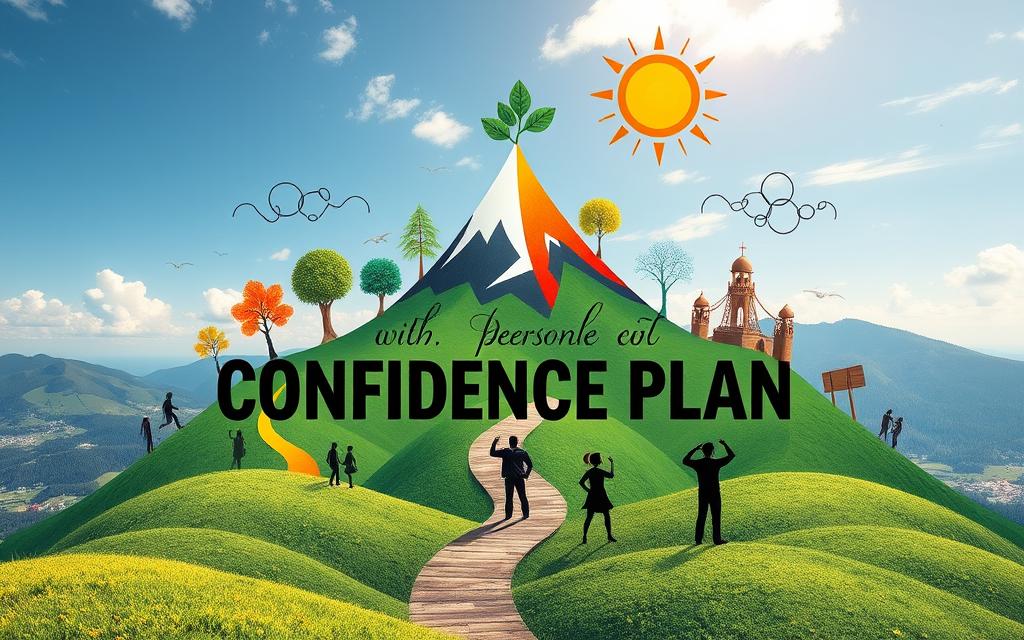Have you ever looked in the mirror and wished you could see the confident person you know you are? Self-confidence is a skill you can build with the right exercises. I’ve struggled with low self-esteem, but I’ve learned it’s possible to become confident.
According to Psychology Today, confident people have better relationships and motivation. Studies show our brains respect confident people more. It’s time to tap into your inner power.
With exercises and activities, you can change your brain’s thinking. Try power posing, positive affirmations, or setting goals. The path to self-confidence is yours to take. Let’s start this journey together and unlock a more fulfilling life.
Understanding the Foundations of Self-Confidence
Self-confidence is key to our well-being. It shapes how we act, think, and live. It’s influenced by our experiences, social surroundings, and how we see ourselves.
The Psychology Behind Self-Confidence
Confidence is about how sure we are of our skills and abilities. Some people naturally feel more confident. Others need to work on it. Lack of confidence can show in shyness, constant need for approval, and fear of taking risks.
How Confidence Impacts Daily Life
Confidence lets us be our true selves. It helps us face life’s challenges head-on. People with high self-esteem tackle challenges with courage, see mistakes as chances to learn, and have better relationships. On the other hand, low self-esteem can lead to harmful behaviors like substance abuse or self-harm as a way to deal with negative feelings.
The Science of Self-Assurance
Building confidence involves both body language and mental focus. Studies link self-esteem to depression, showing that lack of support and isolation can increase depression risk. To overcome shyness, we need to take action, not just think about it. Confidence is deeply tied to how we present ourselves and communicate non-verbally.
The Power of Positive Affirmations
Positive affirmations are powerful tools for building self-confidence. They remind us of our abilities and worth. Saying things like “I am capable,” “I am worthy of good things,” and “My challenges help me grow” can be helpful. It’s important to repeat these daily, during routines or when negative thoughts pop up.
This habit helps change our brain’s thinking patterns to more positive ones. Over time, this leads to higher self-esteem. Being consistent is key to seeing these changes.
Affirmation activities can also boost confidence and reduce fear of judgment. Self-affirmations create positive changes in thinking patterns and maintain perceived worth and integrity. They remind us of our goals, worth, and values. This helps us feel less stressed when we doubt ourselves.

A 2015 study showed that self-affirmations activate the brain’s rewards center. They also release feel-good hormones. Positive affirmations can motivate us to take action, even when we lack motivation.
There are many ways to practice positive affirmations. You can make lists, create posters, say them out loud, journal, or use mindfulness meditation. These exercises help us focus on the positive.
Using sticky notes, posters, and setting aside an affirmation day can make affirmations a part of our daily lives. Positive affirmations work for all ages, including adults and teenagers. They act as mental exercises to fight off negative thoughts. If you’re struggling with negative thoughts, talking to a therapist might help.
Essential Self-Assurance Building Exercises
Building confidence is a journey. Adding various exercises to your daily routine can boost your self-assurance. Tools like power posing, visualization, and mindfulness help unlock your inner strength.
Power Posing Techniques
Research shows power posing can change your brain chemistry and boost confidence. [confidence exercises] Amy Cuddy’s study found that two minutes of high-power poses increase testosterone and decrease cortisol.
Visualization Methods
Visualization is a strong tool for confidence building. [visualization for confidence] By imagining yourself succeeding, you train your brain to believe in yourself. It’s key to act on these images to make them real.
Mindfulness Practices
Mindfulness techniques are great for confidence. They help you stay present and reduce anxiety. [mindfulness techniques] Regular mindfulness, like meditation, boosts self-confidence over time.
Adding these exercises to your daily life can deeply impact your confidence. Remember, confidence building is a journey. With consistent practice, you can reach your goals with more self-belief.
Overcoming Mental Barriers to Confidence
Building confidence starts with spotting and fighting negative beliefs. It’s key to recognize and question our inner critic. Changing negative thoughts to positive ones can be done by rewriting our mental scripts and using morning affirmations.
Also, celebrating small wins helps build a strong, optimistic mindset. Turning pessimistic thoughts into chances for growth is another way to overcome mental barriers.
Past failures and unrealistic expectations can make us fear failure more. Feeling like we’re not good enough or comparing ourselves to others can also hurt our confidence. To beat these fears, we need to set achievable goals and imagine ourselves succeeding.
Positive self-talk is also crucial. Surrounding ourselves with supportive people and routines can help too. By facing these mental hurdles and growing our mindset, we can reach our full potential and feel more confident.

- Past negative experiences contribute to the fear of failure.
- Unrealistic expectations can enhance the fear of failure.
- Lack of support intensifies the fear of failure.
- Constantly comparing oneself to others can diminish self-confidence.
- Negative self-talk undermines confidence levels.
- Inadequate skills or knowledge contribute to self-doubt.
- Societal pressures lead to feelings of inadequacy.
To overcome these mental barriers, it’s crucial to focus on setting attainable goals, visualizing success, and engaging in positive self-talk. Supportive networks and routines can also play a vital role in building confidence. By addressing these mental obstacles and adopting a growth mindset, individuals can unlock their true potential and develop lasting self-assurance.
Body Language and Confidence Connection
Confident body language is key to feeling sure of oneself. By learning to make eye contact, standing tall, and using non-verbal cues, people can show confidence. This can improve their lives at work and at home.
Mastering Eye Contact
Good eye contact makes you more memorable and likable. It shows confidence and trust. It’s about connecting with others and being present.
Maintaining eye contact helps build rapport and shows self-assurance. Doing eye contact exercises regularly can boost your confidence.
Posture Improvement Techniques
Good posture shows self-assurance. Standing tall with shoulders back and head high boosts confidence. Using posture for confidence techniques can make you feel more confident.
Non-Verbal Communication Skills
Non-verbal cues, like facial expressions and gestures, are key to showing confident body language. A genuine smile and open body language show confidence. Practicing these can make you feel more assured.
Working on these physical aspects of confidence can change your life. Regular practice and self-improvement can turn these behaviors into real feelings of self-assurance.
Goal Setting for Self-Assurance Development
Setting and achieving confidence goals can really boost your self-assurance. Start by keeping a goals journal. Write down specific steps to reach each goal, obstacles you might face, and how to overcome them.
Check your progress every week and adjust as needed. Celebrate your wins. This way, you build confidence through real achievements and tracking your progress. Studies show setting SMART goals (Specific, Measurable, Achievable, Relevant, and Time-bound) can increase self-assurance by 70% over time.
- Do a SWOT analysis to find your strengths, weaknesses, opportunities, and threats. This can improve self-awareness and growth areas by 65%.
- Join a mentorship program for valuable insights and guidance. This can boost confidence by 60%.
- Take care of your physical health. Research shows a 40% increase in self-confidence when you focus on your well-being.
- Practice mindfulness and meditation to improve mental well-being. This can increase self-assurance by 30%.
By setting and achieving your self-improvement objectives through this method, you can change your mindset. You’ll build the confidence you deserve.

Social Interaction Exercises
Boosting your social confidence and public speaking skills is easy with fun exercises. Start by talking to everyone you meet, from neighbors to strangers. This builds your comfort in social situations.
Improving your public speaking is also key. Practice speaking in front of people, starting small and growing your audience. Playing cooperative board games can also boost your social skills and help you make friends.
Conversation Practice Methods
- Start conversations with people you see every day, like your barista or local grocer.
- Go to local events or meetups to practice introducing yourself and talking with others.
- Volunteer in your community to meet new people and gain social experience.
Public Speaking Techniques
- Begin with small, easy opportunities to speak, like in a group or meeting.
- Record yourself speaking and watch it to see what you can improve.
- As you get more confident, speak in front of bigger groups.
Group Dynamic Exercises
Cooperative board games, team-building activities, and interactive problem-solving exercises are great for improving your social skills. They help you communicate better, understand others, and solve problems together. These skills are crucial for feeling more confident in social situations.
By trying different social exercises, you can become more confident and skilled in social situations. Remember, building social confidence takes time and practice. Keep working at it to reach your full potential.
Building Professional Confidence
Building confidence at work is key to success. It means learning job skills, keeping up with trends, and building a strong network. The Meisner Technique helps by teaching you to be present and true to yourself, which boosts your confidence at work.
Top business schools know how important confidence is. They use improv to teach students how to sell, market, and present better. This shows how well these methods work.
The Stanislavski System helps you show emotions naturally. By practicing, you can feel more confident and communicate better at work.
- Start talking to your coworkers to feel more at ease.
- Imagine yourself doing well in professional situations.
- Listen to your voice to improve how clear and loud you sound.
- Be proud of your achievements to feel more confident.
- Ask for feedback from others to learn and grow.
Practicing confidence every day can make you better at talking and interacting. By working on your confidence, you open doors to new career chances and growth.
Daily Habits for Lasting Confidence
Building confidence is a journey, not a one-time thing. Developing daily habits can help you keep feeling confident. Morning routines and evening reflection can make a big difference.
Morning Confidence Routines
Begin your day with activities that boost your self-esteem. Positive affirmations can change your mindset for the better. Power posing can also make you feel more confident. A short meditation can help you start the day feeling calm and confident.
Evening Reflection Practices
- Every evening, take time to think about your day. Gratitude journaling can really help your self-esteem.
- Look back at your day and celebrate your wins, big or small. This boosts your belief in yourself.
- Do self-compassion exercises, like writing a kind letter to yourself. It fights off negative thoughts.
These habits build a strong foundation for lasting confidence. They help you face each day with more self-assurance. Start these practices and see your confidence grow over time.
Measuring Progress and Success
Tracking your confidence journey is key for growth and self-improvement. By regularly assessing your progress, you can see your strengths, celebrate wins, and find areas to improve. This self-improvement assessment unlocks lasting confidence.
Self-assessment tools are great for tracking confidence progress. Tools like journaling, reflection, and feedback from loved ones help. They let you see how you’re doing in social life, work, and personal goals.
- Use self-reflection to find growth and celebrate your wins.
- Get feedback from friends, family, or mentors for a full view of your confidence growth.
- Try a “Certificate of Recognition” system to mark your progress and achievements.
Regular progress evaluation boosts your confidence and shows where you need to work more. By tracking your journey, you stay motivated, spot patterns, and make smart choices for your self-improvement.

Embracing confidence tracking and self-improvement assessment is a big step towards reaching your full potential. Celebrate your wins, learn from your experiences, and keep building confidence for a more fulfilling life.
Maintaining Confidence Under Pressure
In today’s fast world, keeping your cool in tough times is key. Whether it’s a big presentation, a tough talk, or a sudden crisis, how you handle it matters a lot. It can affect your success and happiness.
Stress management, confidence in challenging situations, and resilience building are crucial. They help you deal with life’s surprises. By learning to stay calm and confident, you can get through tough times and come out stronger.
- Try the Stanislavski System: This acting method uses memories of success to boost confidence. Think back to times when you felt good and were successful.
- Use Deep Breathing and Visualization: When things get tight, breathe deeply and imagine yourself doing well. This keeps you calm and focused.
- Get Ready Well in Advance: Feeling prepared boosts your confidence. Think ahead and plan for any problems. This helps you stay calm.
- Think About Your Past Wins: Remember times you’ve beaten challenges. This builds your belief in yourself and gives you the courage to face new ones.
Remember, confidence is something you work on every day. By using these tips, you can build the resilience and self-assurance needed to succeed, even when things get tough.
Creating Your Personal Confidence Strategy
Creating a personalized confidence plan is key to unlocking your true potential. By mixing self-assurance building techniques that fit you, you can craft a confidence building strategy for success.
First, find your unique strengths and positive traits. Do an “I Am” activity, like making a visual board or collage. It shows your best self and boosts your self-worth.
Then, add affirmations, physical exercises, social interactions, and professional growth to your daily life. Say empowering mantras, practice power posing, and do mindfulness to boost your self-belief. Also, step out of your comfort zone by making bold requests or volunteering. This will help your self-assurance.
Keep checking and tweaking your personalized confidence strategy as you grow. Celebrate your wins, learn from failures, and adjust your plan as needed. Remember, building self-confidence is a journey. With dedication and kindness to yourself, you can reach your full potential.

Conclusion
Building self-confidence is a journey that never ends. It takes hard work and practice every day. Understanding the basics of confidence is key. You also need to try different exercises and techniques.
It’s important to face your fears and build daily habits that support you. Remember, you can grow your self-confidence over time.
Stay dedicated to your growth and celebrate your wins. Keep improving your ways to build confidence. This will help you reach your goals and face challenges head-on.
Building self-confidence is a lifelong path. But with the right attitude and effort, you can grow strong and resilient. Keep learning and embracing self-assurance for a brighter future.
